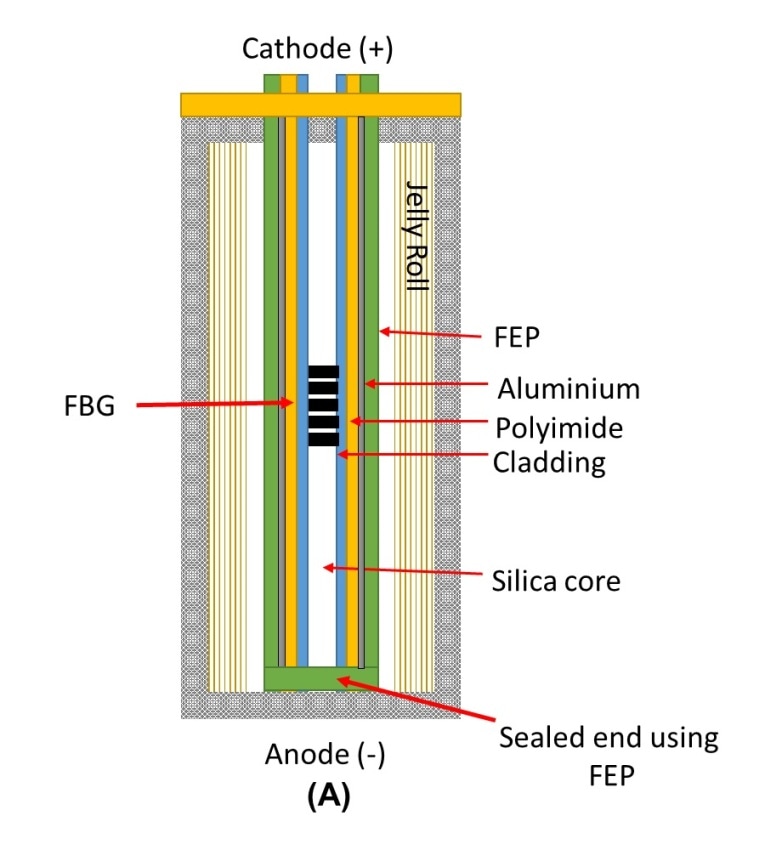Feb 19 2018
Scientists at WMG at the University of Warwick have discovered that Lithium-ion batteries can be safely charged up to five times faster than the present recommended maximum charging limits. This was revealed by their newly developed direct, precise test of the internal temperatures and the electrodes potentials of the Lithium-ion batteries.
 Lithium battery temperature sensor. (Credit: WMG, University of Warwick)
Lithium battery temperature sensor. (Credit: WMG, University of Warwick)
According to the team, the latest technology works in-situ during the normal operation of a battery without affecting its performance and it has also been tested on standard batteries that are commercially available in the market. Such latest technology will allow developments in flexible battery charging rates, battery materials science, and electrical and thermal engineering of innovative battery materials/technology. It also has the ability to aid the design of advanced energy storage systems for high-performance applications, for example, grid balancing and motor racing.
When a battery becomes over heated, it can cause extreme damage especially to its electrolyte and can even lead to hazardous situations where the electrolyte disintegrates to form gases that are not only flammable but also cause considerable pressure build up. When the anode is overcharged, it can result in so much Lithium electroplating that it produces metallic dendrites and ultimately pierces the separator, promoting an internal short circuit with the cathode and leading to subsequent catastrophic failure.
To prevent this, manufacturers generally specify a maximum charging intensity or rate for batteries depending on what they believe are the critical temperature and potential levels to avoid. However, so far, internal temperature testing (and gaining data on each electrode's potential) in a battery has shown to be either impractical or impossible without considerably impacting the performance of the batteries.
Manufacturers are forced to depend on a restricted, external instrumentation. Apparently, this approach fails to give precise readings and as a result, manufacturers assign extremely conservative limits on maximum charging intensity or speed to make sure that the battery is not damaged, or in worst scenario, suffers catastrophic failure.
Conversely, scientists at WMG at the University of Warwick have been devising a new series of techniques that enables direct and highly precise internal temperature as well as “per-electrode” status monitoring of Lithium-ion batteries of different destination and formats. These techniques can be used during the normal operation of a battery without affecting its performance and they have also been tested on commercial automotive-class batteries. The data obtained through such techniques is much more accurate than external sensing, and the WMG team was able to establish that lithium batteries that are commercially available today could be charged up to five times faster than the present recommended maximum charging rates.
The WMG team has published the study in the prestigious journal, Electrochimica Acta, in a paper entitled “Understanding the limits of rapid charging using instrumented commercial 18650 high-energy Li-ion cells”
Dr Tazdin Amietszajew WMG researcher University of Warwick Dr Tazdin Amietszajew, the WMG researcher who headed the study, said:
“This could bring huge benefits to areas such as motor racing which would gain obvious benefits from being able to push the performance limits, but it also creates massive opportunities for consumers and energy storage providers. Faster charging as always comes at the expense of overall battery life but many consumers would welcome the ability to charge a vehicle battery quickly when short journey times are required and then to switch to standard charge periods at other times. Having that flexibility in charging strategies might even/further down the line help consumers benefit from financial incentives from power companies seeking to balance grid supplies using vehicles connected to the grid.”
This technology is ready to apply now to commercial batteries but we would need to ensure that battery management systems on vehicles, and that the infrastructure being put in for electric vehicles, are able to accommodate variable charging rates that would include these new more precisely tuned profiles/limits.
Dr Tazdin Amietszajew
The technology developed by the WMG team for this novel direct in-situ battery sensing uses miniature reference electrodes as well as Fiber Bragg Gratings (FBG) that are threaded via bespoke strain protection layer. Over the fiber, an outer skin of fluorinated ethylene propylene (FEP) was applied which provides chemical protection against the corrosive electrolyte. The outcome is a device that can have direct contact with all the cortical parts of the battery and tolerate mechanical, electrical, and chemical stress inflicted during the operation of the batteries whilst still allowing accurate temperature and potential readings.
WMG Associate Professor Dr Rohit Bhagat who was also one of the researchers on the paper said:
“This method gave us a novel instrumentation design for use on commercial 18650 cells that minimises the adverse and previously unavoidable alterations to the cell geometry. The device included an in-situ reference electrode coupled with an optical fibre temperature sensor. We are confident that similar techniques can also be developed for use in pouch cells.”
Our research group in WMG has been working on a number of technological solutions to this problem and this is just the first that we have brought to publication. We hope to publish our work on other innovative approaches to this challenge within the next year.
Dr Rohit Bhagat